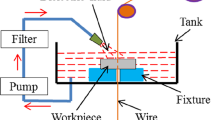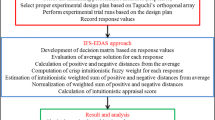Abstract
Since the last few decades, there have been tremendous technological advancements in communication, aeronautics, automobiles, textile engineering, nuclear energy, medical sciences and die-making industries. These have necessitated the use of some totally new and hitherto unknown high-strength temperature-resistant, tough and difficult-to-machine materials and, consequently, some newer unconventional processes for their efficient machining. It has been well established that non-traditional machining processes (NTMPs) far surpass their traditional counterparts in machining such advanced materials with respect to tolerance, surface finish, accuracy, complexity and miniatureness of the machined product/part. These NTMPs are also found to be more effective and economical. Choosing the most appropriate NTMP for generation of a desired shape feature on a given work material involves consideration of numerous conflicting qualitative and quantitative criteria. This paper proposes the application of fuzzy axiomatic design principles for selection of the most suitable NTMPs for generating cavities on ceramics and micro-holes on hardened tool steel and titanium materials, based on their practical/industrial importance. For micro-drilling operation on hardened tool steel, electrical discharge machining is found to be the best process followed by abrasive jet machining and ultrasonic machining. On the other hand, for generation of micro-holes on titanium, electrochemical machining is the most suitable process. Abrasive jet machining emerges out as the most efficient process for generating blind cavities on ceramics. These results are well in accordance with the expected machining practices and perfectly match with the decisions of the machining professionals.
Similar content being viewed by others
References
Jain VK (2005) Advanced machining processes. Allied Publishers, New Delhi
Pandey PC, Shan HS (1981) Modern machining processes. Tata McGraw-Hill, New Delhi
Chakladar ND, Chakraborty S (2008) A combined TOPSIS-AHP-method-based approach for non-traditional machining processes selection. Proc Inst Mech Eng J Eng Manuf 222:1613–1623
Cogun C (1994) Computer-aided preliminary selection of nontraditional machining processes. Int J Mach Tools Manuf 34:315–326
Yurdakul M, Cogun C (2003) Development of a multi-attribute selection procedure for non-traditional machining processes. Proc Inst Mech Eng J Eng Manuf 217:993–1009
Chakraborty S, Dey S (2006) Design of an analytic-hierarchy process-based expert system for non-traditional machining process selection. Int J Adv Manuf Technol 31:490–500
Chakraborty S, Dey S (2007) QFD-based expert system for nontraditional machining processes selection. Expert Syst Appl 32:1208–1217
Edison CR, Jehadeesan R, Raajenthiren M (2008) Web-based knowledge base system for selection of non-traditional machining processes. Malays J Comput Sci 21:45–56
Chakladar ND, Das R, Chakraborty S (2009) A digraph-based expert system for nontraditional machining processes selection. Int J Adv Manuf Technol 43:226–237
Suguraman V, Muralidharan V, Hegde BK, Ravi TC (2010) Intelligent process selection for NTM—a neural network approach. Int J Ind Eng Res Dev 1:87–96
Tozan H (2011) Fuzzy AHP based decision support system for technology selection in abrasive water jet cutting processes. Tech Gazette 18:187–191
Sadhu A, Chakraborty S (2011) Non-traditional machining processes selection using data envelopment analysis (DEA). Expert Syst Appl 38:8770–8781
Chakraborty S (2011) Applications of the MOORA method for decision making in manufacturing environment. Int J Adv Manuf Technol 54:1155–1166
Das S, Chakraborty S (2011) Selection of non-traditional machining processes using analytic network process. J Manuf Syst 30:41–53
Karande P, Chakraborty S (2012) Application of PROMETHEE-GAIA method for non-traditional machining processes selection. Manag Sci Lett 2:2049–2060
Temuçin T, Tozan H, Valíček J, Harničárová M (2013) A fuzzy based decision support model for non-traditional machining process selection. Tech Gazette 20:787–793
Chatterjee P, Chakraborty S (2013) Nontraditional machining processes selection using evaluation of mixed data method. Int J Adv Manuf Technol 68:1613–1626
Temuçin T, Tozan H, Vayvay Ö, Harničárová M, Valíček J (2014) A fuzzy based decision model for nontraditional machining process selection. Int J Adv Manuf Technol 70:2275–2282
Srinivasan S, Srivatsan L, Sathyanarayan R, Ramnath BV (2014) MCDM model for selection of optimum machining process. Mater Sci Forum 773–774:348–354
Prasad K, Chakraborty S (2014) A decision-making model for non-traditional machining processes selection. Decis Sci Lett 3:467–478
Prasad K, Chakraborty S (2014) An expert system for non-traditional machining process selection. Proc. of 5th International & 26th All India Manufacturing Technology, Design and Research Conference (AIMTDR 2014), IIT Guwahati, India, 199(1)–199(7)
Zadeh LA (1965) Fuzzy sets. Inf Control 8:338–353
Zadeh LA (1975) The concept of a linguistic variable and its application to approximate reasoning—I & II. Inf Sci 8:199–249
Suh NP (1990) The principles of design. Oxford University Press, New York
Suh NP (2001) Axiomatic design: advances and applications. Oxford University Press, New York
Kulak O, Kahraman C (2005) Multi-attribute comparison of advanced manufacturing systems using fuzzy vs. crisp axiomatic design approach. Int J Prod Econ 95:415–424
Shigematsu I, Kanayama K, Tsuge A, Nakamura M (1998) Analysis of constituents generated with laser machining of Si3N4 and SiC. J Mater Sci Lett 17:737–739
Rozzi JC, Pfefferkorn FE, Shin YC, Incropera FP (2000) Experimental evaluation of the laser assisted machining of silicon nitride ceramics. Trans ASME J Manuf Sci Eng 122:666–670
Dhupal D, Doloi B, Bhattacharyya B (2008) Parametric analysis and optimization of Nd:YAG laser micro-grooving of aluminum titanate (Al2TiO5) ceramics. Int J Adv Manuf Technol 36:883–893
Ting HT, Abou-El-Hossein KA, Chua HB (2009) Review of micromachining of ceramics by etching. Trans Nonferrous Metals Soc China 19:1–16
Author information
Authors and Affiliations
Corresponding author
Rights and permissions
About this article
Cite this article
Khandekar, A.V., Chakraborty, S. Application of fuzzy axiomatic design principles for selection of non-traditional machining processes. Int J Adv Manuf Technol 83, 529–543 (2016). https://doi.org/10.1007/s00170-015-7608-y
Received:
Accepted:
Published:
Issue Date:
DOI: https://doi.org/10.1007/s00170-015-7608-y




